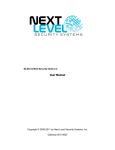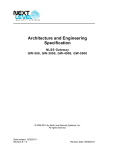Download NLSS DC-400-2 HD Decoder Quick Start Guide
Transcript
NLSS DC-400-2 HD Decoder Quick Start Guide The NLSS DC-400-2 HD Decoder is a 1080p HD device that simultaneously decodes and displays up to 16 HD or SD video streams from compatible IP cameras, video streams, and local files. The decoder is based on PSIA standards, and operates with RTSP, RTMP, and HTTP protocols. This Quick Start Guide provides high level instructions for getting the decoder set up and running. For detailed instructions, and more information on configuration and operations, see the NLSS HD Decoder User Manual, available from the Documentation page of the NLSS web site: nlss.com/support-docs.html. PACKING LIST The following items come with are included with the NLSS HD Decoder: • DC-400-2 Decoder • Stand and monitor mount • Power supply • Utility CD • Remote Control • NLSS DC-400-2 HD Decoder: Quick Start Guide (this document) SYSTEM REQUIREMENTS For a list of supported cameras, displays, file types, and codecs, see the Supported Device List on the NLSS web site: www.nlss.com/support-kbase.html • Network: a 100/1000 Mb Ethernet connection. • Display: any monitor or television with HDMI or DVI-D inputs. • Cameras and Discovery Protocols: IP cameras must be on the same sub-network and use one of the following protocols: Arecont, Panasonic, UPnP, Axis, Pelco, Bonjour Zero Config, Sony • Computer with Web Browser: the NLSS Web Interface runs on Windows, Linux, Macintosh or Android-based operating systems using: FireFox (3.0 or above), Safari (3.0 or above), Internet Explorer (8.0 or above), Chrome (16.0) or above. The computer must be able to ping the decoder to access it. © Next Level Security Systems, Inc. 2009-2012 1 NLSS DC-400-2 HD Decoder Quick Start Guide v3.1 DC-20121221 INSTALLATION These instructions provide a high level installation procedure. For more information, see the NLSS HD Decoder User Manual available from the Documentation page of the NLSS web site: nlss.com/support-docs.html. 1. Ensure that IP cameras are installed and running on the same sub-network on which the NLSS HD Decoder is being installed. 2. Connect a 1080p monitor or TV to the HDMI port of the NLSS HD Decoder. Note: If using the DVI port, a direct DVI-DVI or DVI-HDMI link is required. DVI-VGA is not supported. The older model, the DC-400, does not have a DVI port. 3. Connect the NLSS HD Decoder to a network. 4. Plug the power cord of the NLSS HD Decoder into an AC outlet, and turn it on. 5. Insert the supplied NLSS Discovery Utility CD into the disc drive of a Windows-based computer on the same sub-network as the decoder. – The NLSS Discovery Utility requires Windows XP or later, with .NET 2.0 or above. – After the decoder is installed, any computer running a supported browser, can access the NLSS Web Interface to configure and control the decoder. 6. Copy the Utility file from the CD to the computer’s hard drive. 7. Open the Utility. 8. Click Scan in the Utility screen to find the NLSS HD Decoders on the network. The Utility list all the NLSS HD Decoders that it discovers. 9. Click the IP Address of the Decoder to display NLSS Web Interface its login screen in a browser window. – If auto-discovery fails to find the NLSS HD Decoder, see the instructions for manual discovery in the Configure the Decoder on the Network section of the NLSS HD Decoder User Guide. 10. In the NLSS Web Interface, log in to the NLSS HD Decoder using the default username and password. It is recommended that the default password be changed after logging in. – User: superuser – Pass: superuser 11. After logging in to the NLSS HD Decoder for the first time, complete the following items. a. Customize the default passwords for the Superuser and Operator. b. Select Decoder in the Main Menu to display the Decoder General tab. Important: If the network is not using DHCP, then a link-local address is assigned to the decoder (169.254.x.x) when it is connected to the network. A static IP address must be entered in the IP Address field for the Decoder to communicate outside the local network. c. Click Check Update under the Administration options to see if new firmware is available for the decoder. If so, update the firmware to the latest version. © Next Level Security Systems, Inc. 2009-2012 2 NLSS DC-400-2 HD Decoder Quick Start Guide v3.1 DC-20121221 d. Set the Global Password to match the global password that set on the cameras to be used by the decoder. e. Open the Advanced tab and set the date and time. These settings can be done manually, or via an NTP server. » The Timezone must be set whether setting the time via an NTP server or manually. After the decoder is installed and running, it automatically completes the following tasks: • Discovers all compatible cameras on the network. • Lists these cameras in the Cameras menu of the NLSS Web Interface. • Creates a separate Channel for each camera that the decoder can read. • Creates a 1x1 View for each Channel. • Creates a channel containing the NLSS logo video, and displays this Channel on the monitor attached to the Decoder. BASIC OPERATION The following instructions assume that the Decoder is installed, has discovered at least one live camera on the network, and is receiving a video stream from that camera. The simplest method to view a camera is to display its channel. 1. Select the Channels menu from the Main Menu of the NLSS Web Interface. 2. Select a Channel in the Channels List. The channel information is displayed for the selected channel. 3. Click Set Active to display the channel on the attached monitor. See the NLSS HD Decoder User Manual for complete operations instructions. The manual is available from the Documentation page of the NLSS web site: nlss.com/support-docs.html. CONTACT INFORMATION For support in North America, Central America, South America: Call: 1-760-444-1410 Email: [email protected] For support in Europe, Middle East, and Africa: Call: +49 2433 4469 1025 Email: [email protected] © Next Level Security Systems, Inc. 2009-2012 3 NLSS DC-400-2 HD Decoder Quick Start Guide v3.1 DC-20121221 FCC STATEMENT This device complies with Part 15 of the Federal Communications Commission (FCC) Rules. Operation is subject to the following two conditions: • This device may not cause harmful inference, and This device must accept any interference received including interference that may cause undesired operation. This equipment has been tested and found to comply with the limits for a Class B digital device, pursuant to Part 15 of the FCC Rules. These limits are designed to provide reasonable protection against harmful interference in a residential installation. This equipment generates, uses and can radiate radio frequency energy and, if not installed and used in accordance with manufacturer’s instructions, may cause harmful interference to radio communications. However, there is no guarantee that interference will not occur in a particular installation. If this equipment does cause harmful interference to radio or television reception, which can be determined by turning the equipment off and on, the user is encouraged to try to correct the interference by one or more of the following measures: • Reorient or relocate the receiving antenna. • Increase the separation between the equipment and receiver. • Connect the equipment to an outlet on a circuit different from that to which the receiver is connected. • Consult the dealer or an experienced radio/TV technician for help. CAUTION: Any changes or modifications not expressly approved by the grantee of this device could void the user’s authority to operate this equipment. CE Mark Warning This is a Class B product. In a domestic environment, this product may cause radio interference, in which case the user may be required to take adequate measures. Product Disposal Notice This product (electrical, electronic equipment, and mercury-containing button cell battery) should not be placed in municipal waste. Check local regulations for disposal of electronic products. SAFETY INSTRUCTIONS The system is designed and tested to meet the latest standards of safety for information technology equipment. However, to ensure safety, it is important to read the following safety instructions. Setting Up the System • Read and follow all instructions in the documentation before operating the system. • Do not use this product near water or a heated source such as a radiator. • Set up the system on a stable surface. • Openings on the chassis are for ventilation. Do not block or cover these openings. Leave plenty of space around the system for ventilation. Never insert objects of any kind into the ventilation openings. • Use this product in environments with ambient temperatures between 0˚C and 40˚C. • If using an extension cord, make sure that the total ampere rating of the devices plugged into the extension cord does not exceed its ampere rating. No Disassembly The warranty does not apply to products that have been disassembled by users. Next Level Security Systems, Inc. 6353 Corte Del Abeto, Suite 102 Carlsbad, CA 92011 +1 (760) 444-1410 www.nlss.com © Next Level Security Systems, Inc. 2009-2012 FOR MORE INFORMATION: Please refer to our web site at: www.nlss.com, or contact us at 760-444-1410 © 2011 Next Level Security Systems, Inc. All rights reserved. Product specifications subject to change without notice. Next Level Security Systems® is a registered trademark of Next Level Security Systems, Inc. 4










